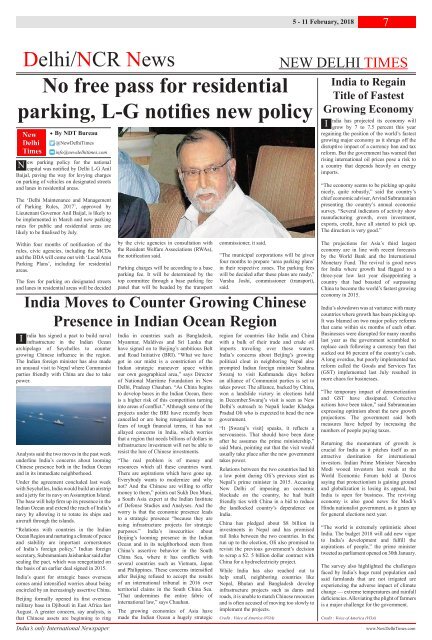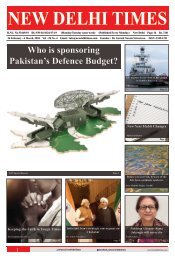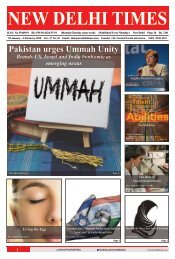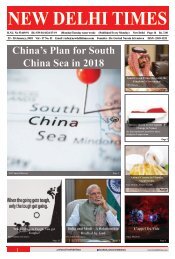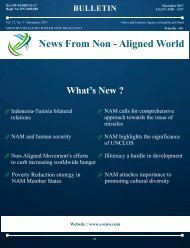5-11 February 2018 - 16-min
Create successful ePaper yourself
Turn your PDF publications into a flip-book with our unique Google optimized e-Paper software.
5 - <strong>11</strong> <strong>February</strong>, <strong>2018</strong> 7<br />
N<br />
Delhi/NCR News<br />
No free pass for residential<br />
parking, L-G notifies new policy<br />
◆◆By NDT Bureau<br />
@NewDelhiTimes<br />
info@newdelhitimes.com<br />
ew parking policy for the national<br />
capital was notified by Delhi L-G Anil<br />
Baijal, paving the way for levying charges<br />
on parking of vehicles on designated streets<br />
and lanes in residential areas.<br />
The ‘Delhi Maintenance and Management<br />
of Parking Rules, 2017’, approved by<br />
Lieutenant Governor Anil Baijal, is likely to<br />
be implemented in March and new parking<br />
rates for public and residential areas are<br />
likely to be finalised by July.<br />
NEW DELHI TIMES<br />
India to Regain<br />
Title of Fastest<br />
Growing Economy<br />
I<br />
ndia has projected its economy will<br />
grow by 7 to 7.5 percent this year<br />
regaining the position of the world’s fastest<br />
growing major economy as it shrugs off the<br />
disruptive impact of a currency ban and tax<br />
reform. But the government has warned that<br />
rising international oil prices pose a risk to<br />
a country that depends heavily on energy<br />
imports.<br />
“The economy seems to be picking up quite<br />
nicely, quite robustly,” said the country’s<br />
chief economic adviser, Arvind Subramanian<br />
presenting the country’s annual economic<br />
survey. “Several indicators of activity show<br />
manufacturing growth, even investment,<br />
exports, credit, have all started to pick up.<br />
The direction is very good.”<br />
Within four months of notification of the<br />
rules, civic agencies, including the MCDs<br />
and the DDA will come out with ‘Local Area<br />
Parking Plans’, including for residential<br />
areas.<br />
The fees for parking on designated streets<br />
and lanes in residential areas will be decided<br />
I<br />
India’s only International Newspaper<br />
by the civic agencies in consultation with<br />
the Resident Welfare Associations (RWAs),<br />
the notification said.<br />
Parking charges will be according to a base<br />
parking fee. It will be deter<strong>min</strong>ed by the<br />
top committee through a base parking fee<br />
panel that will be headed by the transport<br />
commissioner, it said.<br />
“The municipal corporations will be given<br />
four months to prepare ‘area parking plans’<br />
in their respective zones. The parking fees<br />
will be decided after these plans are ready,”<br />
Varsha Joshi, commissioner (transport),<br />
said.<br />
India Moves to Counter Growing Chinese<br />
Presence in Indian Ocean Region<br />
ndia has signed a pact to build naval<br />
infrastructure in the Indian Ocean<br />
archipelago of Seychelles to counter<br />
growing Chinese influence in the region.<br />
The Indian foreign <strong>min</strong>ister has also made<br />
an unusual visit to Nepal where Communist<br />
parties friendly with China are due to take<br />
power.<br />
Analysts said the two moves in the past week<br />
underline India’s concerns about loo<strong>min</strong>g<br />
Chinese presence both in the Indian Ocean<br />
and in its immediate neighborhood.<br />
Under the agreement concluded last week<br />
with Seychelles, India would build an airstrip<br />
and a jetty for its navy on Assumption Island.<br />
The base will help firm up its presence in the<br />
Indian Ocean and extend the reach of India’s<br />
navy by allowing it to rotate its ships and<br />
aircraft through the islands.<br />
“Relations with countries in the Indian<br />
Ocean Region and nurturing a climate of peace<br />
and stability are important cornerstones<br />
of India’s foreign policy,” Indian foreign<br />
secretary, Subramaniam Jaishankar said after<br />
sealing the pact, which was renegotiated on<br />
the basis of an earlier deal signed in 2015.<br />
India’s quest for strategic bases overseas<br />
comes amid intensified worries about being<br />
encircled by an increasingly assertive China.<br />
Beijing formally opened its first overseas<br />
military base in Djibouti in East Africa last<br />
August. A greater concern, say analysts, is<br />
that Chinese assets are beginning to ring<br />
India in countries such as Bangladesh,<br />
Myanmar, Maldives and Sri Lanka that<br />
have signed on to Beijing’s ambitious Belt<br />
and Road Initiative (BRI). “What we have<br />
got in our midst is a constriction of the<br />
Indian strategic maneuver space within<br />
our own geographical area,” says Director<br />
of National Maritime Foundation in New<br />
Delhi, Pradeep Chauhan. “As China begins<br />
to develop bases in the Indian Ocean, there<br />
is a higher risk of this competition turning<br />
into areas of conflict.” Although some of the<br />
projects under the BRI have recently been<br />
cancelled or are being renegotiated due to<br />
fears of tough financial terms, it has not<br />
allayed concerns in India, which worries<br />
that a region that needs billions of dollars in<br />
infrastructure investment will not be able to<br />
resist the lure of Chinese investments.<br />
“The real problem is of money and<br />
resources which all these countries want.<br />
There are aspirations which have gone up.<br />
Everybody wants to modernize and why<br />
not? And the Chinese are willing to offer<br />
money to them,” points out Sukh Deo Muni,<br />
a South Asia expert at the Indian Institute<br />
of Defense Studies and Analyses. And the<br />
worry is that the economic presence leads<br />
to a strategic presence “because they are<br />
using infrastructure projects for strategic<br />
purposes.” India’s insecurities about<br />
Beijing’s loo<strong>min</strong>g presence in the Indian<br />
Ocean and in its neighborhood stem from<br />
China’s assertive behavior in the South<br />
China Sea, where it has conflicts with<br />
several countries such as Vietnam, Japan<br />
and Philippines. These concerns intensified<br />
after Beijing refused to accept the results<br />
of an international tribunal in 20<strong>16</strong> over<br />
territorial claims in the South China Sea.<br />
“That under<strong>min</strong>es the entire fabric of<br />
international law,” says Chauhan.<br />
The growing economies of Asia have<br />
made the Indian Ocean a hugely strategic<br />
region for countries like India and China<br />
with a bulk of their trade and crude oil<br />
imports traveling over these waters.<br />
India’s concerns about Beijing’s growing<br />
political clout in neighboring Nepal also<br />
prompted Indian foreign <strong>min</strong>ister Sushma<br />
Swaraj to visit Kathmandu days before<br />
an alliance of Communist parties is set to<br />
takes power. The alliance, backed by China,<br />
won a landslide victory in elections held<br />
in December.Swaraj’s visit is seen as New<br />
Delhi’s outreach to Nepali leader Khadga<br />
Pradad Oli who is expected to head the new<br />
government.<br />
“It [Swaraj’s visit] speaks, it reflects a<br />
nervousness. That should have been done<br />
after he assumes the prime <strong>min</strong>istership,”<br />
said Muni, pointing out that the visit would<br />
usually take place after the new government<br />
takes power.<br />
Relations between the two countries had hit<br />
a low point during Oli’s previous stint as<br />
Nepal’s prime <strong>min</strong>ister in 2015. Accusing<br />
New Delhi of imposing an economic<br />
blockade on the country, he had built<br />
friendly ties with China in a bid to reduce<br />
the landlocked country’s dependence on<br />
India.<br />
China has pledged about $8 billion in<br />
investments in Nepal and has promised<br />
rail links between the two countries. In the<br />
run up to the election, Oli also promised to<br />
revisit the previous government’s decision<br />
to scrap a $2. 5 billion dollar contract with<br />
China for a hydroelectricity project.<br />
While India has also reached out to<br />
help small, neighboring countries like<br />
Nepal, Bhutan and Bangladesh develop<br />
infrastructure projects such as dams and<br />
roads, it is unable to match Chinese resources<br />
and is often accused of moving too slowly to<br />
implement the projects.<br />
Credit : Voice of America (VOA)<br />
The projections for Asia’s third largest<br />
economy are in line with recent forecasts<br />
by the World Bank and the International<br />
Monetary Fund. The revival is good news<br />
for India where growth had flagged to a<br />
three-year low last year disappointing a<br />
country that had boasted of surpassing<br />
China to become the world’s fastest growing<br />
economy in 2015.<br />
India’s slowdown was at variance with many<br />
countries where growth has been picking up.<br />
It was blamed on two major policy reforms<br />
that came within six months of each other.<br />
Businesses were disrupted for many months<br />
last year as the government scrambled to<br />
replace cash following a currency ban that<br />
sucked out 86 percent of the country’s cash.<br />
A long overdue, but poorly implemented tax<br />
reform called the Goods and Services Tax<br />
(GST) implemented last July resulted in<br />
more chaos for businesses.<br />
“The temporary impact of demonetization<br />
and GST have dissipated. Corrective<br />
actions have been taken,” said Subramanian<br />
expressing optimism about the new growth<br />
projections. The government said both<br />
measures have helped by increasing the<br />
numbers of people paying taxes.<br />
Returning the momentum of growth is<br />
crucial for India as it pitches itself as an<br />
attractive destination for international<br />
investors. Indian Prime Minister Narendra<br />
Modi wooed investors last week at the<br />
World Economic Forum held at Davos<br />
saying that protectionism is gaining ground<br />
and globalization is losing its appeal, but<br />
India is open for business. The reviving<br />
economy is also good news for Modi’s<br />
Hindu nationalist government, as it gears up<br />
for general elections next year.<br />
“The world is extremely optimistic about<br />
India. The budget <strong>2018</strong> will add new vigor<br />
to India’s development and fulfill the<br />
aspirations of people,” the prime <strong>min</strong>ister<br />
tweeted as parliament opened on 30th January.<br />
The survey also highlighted the challenges<br />
faced by India’s huge rural population and<br />
said farmlands that are not irrigated are<br />
experiencing the adverse impact of climate<br />
change — extreme temperatures and rainfall<br />
deficiencies. Alleviating the plight of farmers<br />
is a major challenge for the government.<br />
Credit : Voice of America (VOA)<br />
www.NewDelhiTimes.com


